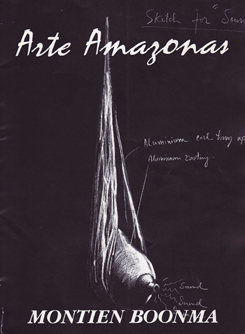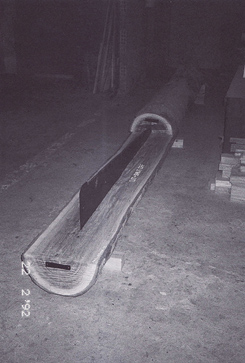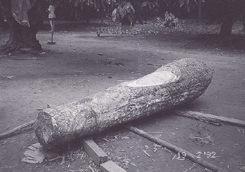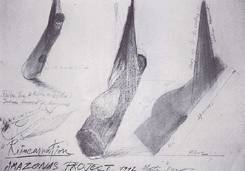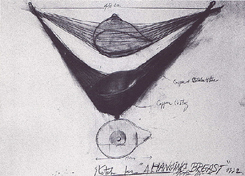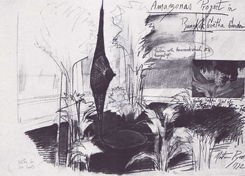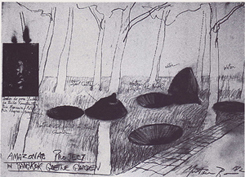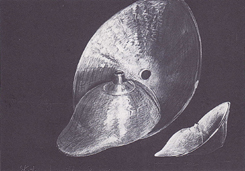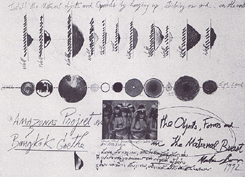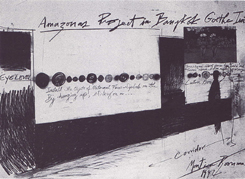Montien Boonma interview: Arte Amazonas (1992)
artdesigncafé - art | 6 August 2010
This interview of Montien Boonma was previously published in the 20-page catalogue Arte Amazonas in 1992 on the occasion of an exhibition with the same name, 4-27 June at the Goethe Institut Bangkok.
Montien Boonma interview
In February 1992, Montien Boonma was invited to Brazil to participate in the artists’ workshop in the Amazon basin, six million square km of river and jungle. Montien stayed and worked in the city of Manaus which was once the center of the world’s rubber industry. For three weeks, he did research around Manaus and communicated with the local Indians and artists from other countries who were invited to this project. His work was executed with a lot of help from the local Indians and will be exhibited in Rio de Janeiro in June 1992.
|
The Goethe Institut Bangkok invited Montien Boonma to show works inspired by his journey to Brazil and his experiences in the Amazon region under the same title Arte Amazonas in June 1992 in Bangkok. The following interview is part of a conversation between the artist Montien Boonma and Alfred Pawlin, founder of Visual Dhamma Gallery. Alfred Pawlin: How did you get invited to participate in Arte Amazonas in Brazil? Montien Boonma: The Goethe Institut Bangkok had sent some information on my work to the organizer. Rainer Wittenborn, a German artist who has held workshops and also exhibited in Bangkok two years ago, was initially invited to the Amazonas workshop. He also recommended me to the organizers as an artist from Thailand. Alfred Pawlin: What is Arte Amazonas all about? Montien Boonma: Arte Amazonas is an international workshop for artists in Brazil. The organizers invited artists to live for some weeks in the Amazon region and work there. Artists lived in 3 important cities of that region: Belém, Manaus and Porto Velho. The Amazon region is the largest area of the Northern states in Brazil and also the largest rainforest in the world. It is one of the last untouched regions in the world, but many industrial companies move in to deforest. The biggest problems are caused by mining and logging. The government of Brazil also wants to build roads through the jungle to connect various cities. Again, trees have to be cut for that project. There are also so many animals and birds in this region, many rare species including plants and fish. The Amazon area has so many functions for the support of life. It is also called ’’the lungs of the earth". To me it is also full of mystery and an opportunity for man to discover the meaning of nature. Alfred Pawlin: Had you prepared your contribution to the exhibition in Thailand already or did you only decide after going to Brazil? Montien Boonma: In this project artists were asked to work at the site and receive inspiration from the Amazon environment. I knew the book The Last Rainforest in Thailand already, and two pictures in this book gave my work a strong direction. One photo showed nude Indian women at work, with uncovered breasts. The other image was of people at work who put a cup to the tree to receive rubber milk. These two images inspired me to see nature as mother. I did sketches on this concept that were sent to Brazil before I went. During my stay in Manaus I went to the island of Terra Nova. I asked the local people for a huge trunk. The island is full of rubber trees, but the locals are sometimes afraid as the trees destroy their houses when they fall. I started to work on a huge trunk that was about 80 years old. I put an oval deepening in the wood and filled it with rubber milk. The elevation in the trunk symbolizes the belly of a pregnant woman. So I called this work Reincarnation. Then I discovered the hammock and how it is used by the Indians. The hammock is really part of their life and their main furniture. In my work I use the hammock to hold the trunk in a diagonal position. |
The title of my work Reincarnation refers to the image of a pregnant woman. But I feel it has also various other meanings. One of these might be that the present situation is bad and we would like to give birth to a new one.
Alfred Pawlin: What do the breasts symbolize in your works?
Montien Boonma: As I told you before, one main inspiration were these pictures in a book of naked women collecting rubber milk. This metaphor of female breasts and milk made me think of the concept "nature as mother’’. In Thailand, we also think that the spirit of trees are female (nang mai).
Man on earth receives everything from nature, like humans in their infancy get food from their mother. But if a mother has too many children who want to drink her milk, they might exhaust her.
|
Alfred Pawlin: In which places will Arte Amazonas be shown? Montien Boonma: It will open in Rio de Janeiro at Museu de Arte Moderna in June 1992. Then the exhibition will move to São Paulo, Brazil. In 1993, the exhibition will be shown at Staatliche Kunsthalle Berlin in Germany. Alfred Pawlin: I noticed that you used different materials for your forthcoming exhibition Arte Amazonas at the Goethe Institut Bangkok. Montien Boonma: In my previous works I have used natural materials like soil, charcoal, ash and terra cotta. This is the first time I am going to use heavy materials like bronze and steel to cast the base. We take materials from the earth and cast them into natural forms again. So the image of nature as mother comes out of the earth. In the Bangkok exhibition I will also use brass which is the same material that we use for Buddha statues in Thailand. The image of the Buddha is very pure and shining and gives some kind of light to the people. For me the image of breasts can be put in a similar context as breasts also represent the power and energy of nature. The surface of my breasts sculpture is very smooth and its fullness is inspired by the volume of Buddha sculptures. The powerful image of breasts full of life should give some kind of energy to people, similar to another kind of energy transmitted through the Buddha image. The brass breasts will be hung in the garden to put it in touch, with and in context to another form of energy, the light of the sun. Alfred Pawlin: For your Arte Amazonas exhibition in Bangkok you will mainly use the garden and the Institut’s outdoor space. Is this the first time you have done that and are you comfortable with the idea? Montien Boonma: I did outdoor sculptures before, in 1984 in the suburbs of Bangkok. I worked on a small lake and in the fields. In 1987 when I studied in Paris, I did sculptures in the garden of a Christian church. The form of the environment is important for me to make choices of what I am going to present. For this show at the Goethe Institut in Bangkok, I will use the small garden in the middle of the building. This garden represents an oasis in the middle of a concrete jungle. I like to make this place interesting for the visitors. Usually people come to this Institut to look at works on the walls or in the rooms, and often people ignore this small greenery. This little garden is also the lungs of the Institut. I hope I can realize my idea and attract people’s attention to this green oasis. |
Alfred Pawlin: Do you see parallels between the situation in Brazil and the one here in Thailand?
Montien Boonma: It is not easy to compare two countries. Thailand also has a rainforest, but on a much smaller scale. In Thailand, only about 5% of the land is forest, and a lot of that is destroyed already. So we might be in a worse position. Not much forest is left and pollution is in the rivers and in the air of the big cities. The quality of soil is also deteriorating in Thailand. So we should put a stop to this now and start to think seriously how we can keep this natural treasure, the soil.
Alfred Pawlin: Should art and artists support modernization in Thailand, or should artists resist this direction?
Montien Boonma: The problem for the artist in his specific society is to get in touch with the feeling of the society he lives in. One has to feel and sense what is happening and what could help the individual and the society. Artists have to have quicker response and finer sensitivity. They should not follow society but present their own concepts. If an artist feels that society is turning in a wrong direction, he has to act and tell the facts. If we are really sensitive, we can predict some directions and also make people understand us better. We do not have to think so much about advancement and progress. The more important thing is the quality of life. I am not against modernization but we have to find solutions for the problems. We took from our ancestors a lot, and now we have the responsibility to choose what to do with it. We cannot return to a primitive life, but
we can find the creativity to solve the problems.
When I work with primitive materials, I want people to rethink the content they stand for. It does not symbolize that I want people to return to the forest. As an artist you are not an expert on environmental problems, but you realize that they exist. Then, if we are sincere about the situation, we can directly show it. But it is not the work of the artist that is the solution. It is the results of the work and what kind of thoughts it inspires in people.
